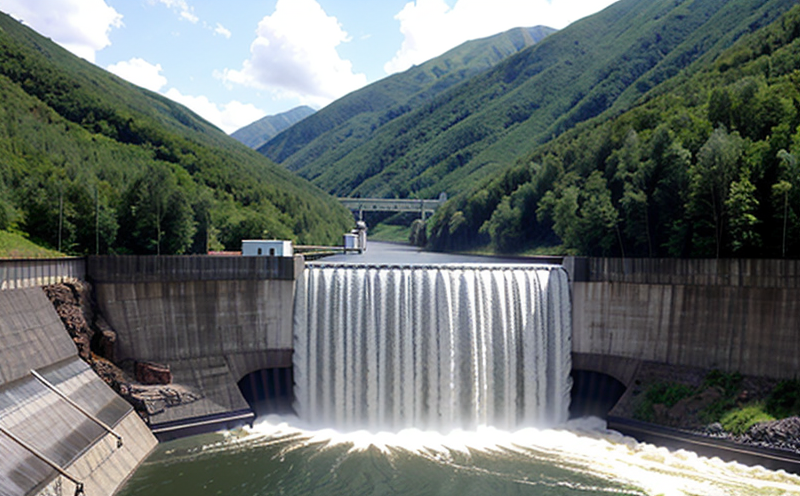ASTM E1417 Liquid Penetrant Testing of Turbine Blades
The ASTM standard E1417 outlines the procedure for non-destructive testing using liquid penetrant inspection (LPI) to detect surface-breaking flaws in the materials used in the production of turbine blades. This service is particularly crucial within the energy sector, especially as hydropower systems evolve towards more efficient and durable designs.
Turbine blades are critical components in hydropower generation facilities, where they convert the kinetic energy from flowing water into mechanical power that drives turbines to generate electricity. The integrity of these blades must be ensured at all times due to the high-stress environment and the potential for catastrophic failure if cracks or defects are not detected early.
ASTM E1417 provides a standardized process using liquid penetrants, which are applied to the surface of the turbine blade to identify any flaws. The penetrant seeps into minute surface-breaking cracks under capillary action, and after drying, a developer is applied to draw out the penetrant from the defects. This visual inspection allows technicians to detect even the smallest imperfections that could lead to failure.
The primary advantage of ASTM E1417 LPI over other non-destructive testing methods lies in its ability to examine the entire surface of the turbine blade without causing damage. This ensures that no critical flaw goes undetected, which is essential for maintaining the safety and efficiency of hydropower facilities.
Our laboratory adheres strictly to ASTM E1417 guidelines to ensure consistent and reliable results. The testing process involves meticulous preparation of the test specimens, ensuring that the surface is clean and free from contamination before applying the penetrant. Our team uses high-quality liquid penetrants and developers, which are crucial for achieving accurate inspections.
The instrumentation used in this service includes advanced visual inspection equipment that can magnify defects detected by LPI. This allows for precise identification and documentation of any flaws found during testing. Reporting is comprehensive, detailing the specific location and nature of each defect identified, along with recommendations for repair or replacement if necessary.
Applied Standards
| Standard | Description |
|---|---|
| ASTM E1417-18 | Procedure for Liquid Penetrant Testing of Turbine Blades to Detect Surface-Breaking Flaws |
The ASTM E1417 standard specifies the detailed procedure and requirements for performing liquid penetrant testing on turbine blades. This includes the type of penetrants, developers, and other materials used, as well as the environmental conditions necessary for accurate results.
Adherence to these standards ensures consistency in test procedures across different facilities, enhancing reliability and comparability of results. Our laboratory is committed to maintaining strict adherence to ASTM E1417 guidelines to deliver consistent and high-quality testing services.
Eurolab Advantages
EuroLab stands out in the field of hydropower turbine blade testing through its advanced facilities, experienced technicians, and stringent adherence to international standards. Our state-of-the-art equipment enables us to perform ASTM E1417 tests with precision and accuracy.
Our team comprises highly skilled professionals who have extensive experience in conducting liquid penetrant inspections for various industries. This expertise ensures that we can identify even the smallest defects, providing our clients with comprehensive insights into the condition of their turbine blades.
We also offer a range of additional services, including metallurgical analysis and material characterization, which complement ASTM E1417 testing by providing deeper insights into the materials used in turbine blade production. This holistic approach helps our clients make informed decisions regarding maintenance and replacement strategies.
Our commitment to quality is further reflected in our ISO 9001:2015 certification, ensuring that every step of the testing process meets the highest industry standards. Clients can trust us for reliable and accurate results that are crucial for maintaining the integrity of hydropower systems.
Use Cases and Application Examples
The ASTM E1417 liquid penetrant testing service is widely used in the energy sector, particularly for the maintenance and reliability assessment of hydropower facilities. Here are some key use cases:
- Maintenance Scheduling: Regular inspections using ASTM E1417 help in scheduling timely maintenance activities to prevent unexpected failures.
- New Blade Introduction: Before incorporating new turbine blades into a facility, it is essential to ensure they meet the required specifications. Testing per ASTM E1417 provides assurance that these components are safe and reliable.
- In-Service Monitoring: Continuous monitoring of existing turbine blades ensures ongoing safety and operational efficiency. This can lead to optimized performance and reduced downtime.
For R&D engineers, this service offers valuable insights into the effectiveness of new materials or design changes. It helps in identifying potential weaknesses early on, allowing for iterative improvements before full-scale deployment.
In addition to these applications, ASTM E1417 testing is also used during procurement processes to ensure that the turbine blades purchased meet the specified quality and safety standards.





